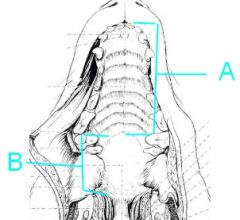![]()
![]()
![]()
Use LEFT and RIGHT arrow keys to navigate between flashcards;
Use UP and DOWN arrow keys to flip the card;
H to show hint;
A reads text to speech;
32 Cards in this Set
- Front
- Back
|
What are the major basic components of the digestive system?
|
Alimentary canal and associated glands
|
|
|
Name some functions of the digestive system.
|
Prehension, ingestion
Mastication Deglutition Digestion Absorption of nutrients Elimination of undigestible/undigested food products |
|
|
What are some of the associated digestive glands?
|
liver, gall bladder, pancreas, salivary glands
|
|
|
What is the rostral opening to the alimentary canal known as?
|
Oral cavity
|
|
|
What are some structures in the oral cavity?
|
Buccal cavity
Lips Cheeks Hard palate Soft palate Tongue Gingiva Teeth |
|
|
What type of epithelium is found in the oral cavity?
|
Stratified squamous epithelium (nonkeratinized to heavily keratinized)
|
|
|
What are the types of oral mucosa?
|
Masticatory mucosa
Lining mucosa Specialized mucosa |
|
|
T or F:
Ruminants, horses, and pigs have cornified lips. |
False!
Pigs (and carnivores) don't have cornified lips. |
|
|
What kinds of glands are found in the buccal cavity?
|
Serous, mucous, and mixed.
|
|
|
What microscopic structures do ruminants have on their lips to help with prehension and mastication?
|
Oral papillae
|
|

Identify A and B
What is the epithelium on the dorsal and ventral side of each structure? |

A - Hard palate - dorsal has respiratory epithelium; cornified stratified squamous epi on ventral
B - Soft palate - ciliated pseudostratefied columnar epi on dorsal; cutaneous mucous membrane on ventral |
|

Identify these papillae! Which are mechanical and which contain taste buds?
|

A - Circumvallate - taste
B - Conical (or lenticular) - mechanical C - Foliate - taste D - Filiform - mechanical E - Fungiform - taste |
|
|
Describe the locations of taste buds on fungiform, foliate, and circumvallate papillae.
|
Taste buds are on the apex for fungiform and on the sides for the other two.
|
|
|
What are the cell types in a taste bud and what is the function of each?
|
Sustentacular (support)
Gustatory (taste receptor) Basal (regeneration) |
|
|
T or F:
A gustatory cell in a taste bud is a modified bipolar neuron. |
False you punk!
nerve endings synapse on the gustatory cells! |
|
|
What is the hardest substance in the body and what is it made of?
|
Enamel
95 - 99% hydroxyapatite |
|

Identifizzle da shiz on dis toof, y'all!
|

A - Crown
B - Root C - Enamel D - Dentin E - Pulp |
|
|
What part of the tooth provides vascularization and innervation?
|
The pulp cavity
|
|
|
What is dentin made of?
|
69% hydroxyapatite
|
|

Identify the parts of this developing tooth.
|

A - Ameloblasts
B - Forming enamel C - Forming dentin D - Odontoblasts E - Forming pulp cavity |
|
|
T or F:
Brachydont ameloblasts disintegrate upon eruption. Therefore dentin is incapable of repair. |
FALSE! READ THE QUESTION NEXT TIME, JERKY!
Ameloblasts do disintegrate upon eruption but they make ENAMEL not DENTIN!!! Odontoblasts make dentin! |
|
|
T or F:
Ameloblasts and odontoblasts are big fans of Marissa Tomei. |
WTF?
These cells do have Tome's processes through which they secrete enamel or dentin |
|
|
What lines dentin below the level of the gingival?
|
Cementum
|
|
|
What attaches the tooth to the alveolar bone?
|
Periodontal ligament
|
|
|
What cells are involved in the formation of cementum?
|
Cementoblasts
|
|

Identify these parts of a tooth
|

A - Crown
B - Gingiva C - Alveolar bone D - Periodontal ligament E - Gingival sulcus |
|
|
What are the two main types of mammalian teeth?
|
Brachydont
Hypsodont |
|
|
T or F:
Hypsodont teeth have enamel covered by cementum while brachydont teeth don't. |
True!
Brachydont teeth have a definite cementum/enamel junction while hypsodont teeth have cementum laid on top of enamel |
|
|
T or F
The main differences between brachydont and hypsodont teeth involve growth rate and mineralization layers |
True!
Hypsodont teeth grow for much of the adult life while brachydont teeth do not grow after eruption completion. Brachydont teeth have a cementum/enamel junction while hypsodont teeth have cementum on top of enamel |
|
|
T or F
Hypsodont teeth never form true crowns. |
True!
|
|
|
What are the invaginations of cementum and enamel on the surface of hypsodont teeth?
|

Infundibula
|
|
|
What is the most entertaining part of a hypsodont tooth?
|
The inFUNdibulum! hahahahahahahahahahahahaha
|

